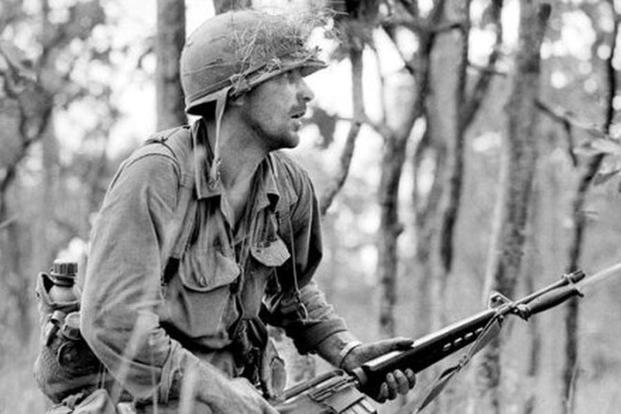The late Army Col. Rick Rescorla, a legend in Vietnam who acted heroically as a civilian in the south tower of the World Trade Center on Sept. 11, 2001, will receive the posthumous award of the Presidential Citizens Medal, the nation's second-highest civilian award after the Presidential Medal of Freedom, the president said this week.
"Rick earned the Silver Star and the Purple Heart for his service in Vietnam," President Donald Trump said at the Pentagon's 9/11 memorial ceremony Wednesday. " ... On the day of the attack, Rick died while leading countless others to safety. His selfless actions saved approximately 2,700 lives."
"Today, I am honored to announce that I will soon be awarding the late Rick Rescorla the Presidential Citizens Medal for his extraordinary sacrifice," Trump added
A photo of Rescorla as a grizzled lieutenant in Vietnam, moving forward with bayonet fixed during the horrific 1965 battle of Ia Drang in Vietnam, became one of the iconic images of the war.
The photo was used on the cover of the gripping account of the battle written by veteran United Press International correspondent Joe Galloway, with Army Lt. Gen. Harold Moore, in the book "We Were Soldiers Once ... And Young."
In the prologue, Galloway wrote: "This, then, is our testament and our tribute to 234 Americans who died beside us in Landing Zone X-Ray and Landing Zone Albany in the Valley of Death, 1965."
The book was made into the movie "We Were Soldiers," starring Mel Gibson in the role of Moore. Rescorla would later say he wouldn't see it.
"All the heroes are dead," he said.
There is a life-sized monument to Rescorla, modeled after the Vietnam photo, at the National Infantry Museum's Memorial Walk of Honor near Fort Benning, Georgia.
In 2015, a conference center at Fort Hood, Texas, was dedicated in his name, and Army officials, his friends and widow, Susan Rescorla, recalled his actions in Vietnam and on Sept. 11, 2001, when he died at age 62.
Cyril Richard "Rick" Rescorla was born in Cornwall and served in the British Army before coming to America at age 24 to be commissioned as a lieutenant and fight in Vietnam.
He had the habit of singing the Cornish and Welsh battle hymns of his youth during times of crisis to buck up the spirits of those around him. He sang them during the worst of it in the battle of Ia Drang, and he sang them again as the towers burned on 9/11.
Sam Fantino, Rescorla's radio operator in 1st Platoon, Company B, 2nd Battalion, 7th Cavalry Regiment, 3rd Armored Brigade Combat Team,1st Cavalry Division, recalled watching him with amazement during the battle of Ia Drang near the Cambodian border.
"We were all sitting in our holes with our knees knocking, we have dead guys all around us, and here comes Rick singing Cornish songs," Fantino said in the Army account of the conference room dedication written by Sgt. Brandon Banzhaf.
Fantino said that "pretty soon you are saying to yourself, 'If this guy can walk from hole to hole checking to see if you have your grenades in the right place, checking to see if you have your magazines, and standing up like he is going on a Sunday afternoon's walk -- what do you have to worry about?'"
Rescorla was head of security for Morgan Stanley when the World Trade Center towers were first attacked in 1993 with a truck bomb, killing six. He believed the towers would be attacked again and planned relentlessly for an evacuation.
In the chaos of the stairwells on Sept. 11, 2001, he was singing again. Few could recall later what the tune was, just that there was a calm and determined man with a British burr to his voice going about his dangerous work with a song.
Dan Hill remembered. One of Rescorla's last phone calls was to his friend, Hill, who had served with him in Vietnam. Hill had worked previously for Rescorla as a security consultant, and Rescorla was now telling him to get up to New York to help deal with the aftermath.
Rescorla broke off to sing again. It was the rousing "Men of Harlech," Hill later told the New Yorker magazine: "Men of Harlech stand ye steady, It cannot be ever said ye, For the battle were not ready, Stand and never yield!"
"Everybody said, 'Rick your folks are out. You've done what you need to do,' but he pointed up the stairwell and said, 'You hear those screams? There's more people up there. I have to help get them out,'" Lt. Col. Andrew Watson, then-commander of the 2nd Battalion of the 7th Cavalry, said at the conference room dedication, according to the Army account.
"How better can you epitomize selfless service to a nation than to first embark on the conflict in Vietnam, and then to continue to serve your community at every level you find yourself," Watson said.
"And to give that last full measure of dedication of service and support in an unexpected terrorist attack that in lesser countries, would bring the country down to their knees, but served as a galvanizing force," Watson said.
Susan Rescorla told the 7th Cav troops at the ceremony that she was so proud of her husband.
"He had a choice. He could have walked out of there anytime he wanted to. If he was here today, he would be proud. This is the 7th Cav, this is our home, our history."
-- Richard Sisk can be reached at Richard.Sisk@military.com.














